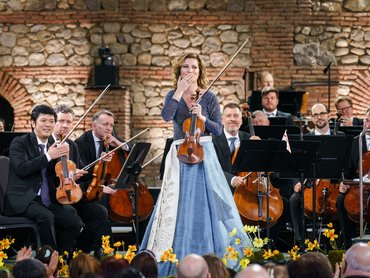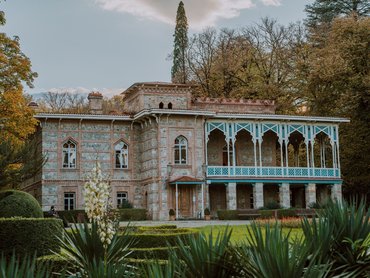
Übersicht
The Georgians reportedly enchanted Igor Stravinsky and even the good Lord Himself with their joie de vivre; they also speak one of the oldest living languages in the world, with its very own alphabet. Tradition is not the only thing writ large in the Caucasus: The small country on the “balcony of Europe” has an equally lively contemporary music scene. We have put together 11 (musical) facts about Georgia to give you an impression in the lead-up to our European Concert on 1 May.
1. It begins with a celebration
There is a founding myth in Georgia that is told with pride. It goes like this: When God called the peoples of the earth together to divide up the countries, the Georgians did not turn up. Why? They were busy celebrating yet another festival. Wine, dancing and singing - time flies when you're having fun. But when God later heard about their joie de vivre and their singing, he was so pleased that he granted them the land that he had actually reserved for himself. Georgia - paradise?
2. Oh, beautiful Georgia
Celebrations and festivals are still important today - as is singing, of course. A typical feast follows a strict ritual. The festive table is richly laid, for example with khachapuri, a pide-like yeast boat filled with cheese, or chinkali, stuffed onion-shaped dumplings. Wine is also served - naturally, in the country where viticulture originated. The central figure is the tamada, who leads the toasts. Without a tamada there can be no toast, without a toast there can be no celebration. Between the toasts there is plenty of singing and dancing - for example "Sakartvelo Lamazo - Oh, you beautiful Georgia".
3. A song of praise from Igor
The singing from Georgia enchanted not only God, but also Igor Stravinsky: "What the Georgians sing is more important than all the new discoveries of modern music. It is incomparable and simple. I have never heard anything better!" The Unesco jury could hardly disagree with Stravinsky's judgement. In 2001, it included the polyphonic singing of Georgia in the list of "Masterpieces of the Oral and Intangible Heritage of Humanity".
4. The balcony of Europe
Borders are always a tricky thing: depending on where you draw them, Georgia is categorised as either Europe or the Middle East. Fittingly, the people themselves refer to their country as the "Balcony of Europe" - still on it, but already outside. About as many people live on this balcony, which is no bigger than Bavaria, as live in Berlin. And yet it is as diverse as an entire continent: 7 climate zones from alpine to tropical, 19 historical regions, up to 15 different musical traditions.
5. Humming bass and rooster's crow
But what is the Georgian music tradition all about? The country is best known for its polyphonic singing - that is, singing with multiple vocal lines. There are basically three different types: In Kakheti and eastern Georgia, two voices sing over a low humming bass; in the western regions, three voices improvise with each other. The polyphony in northern Svaneti is particularly complex. The Chakrulo song, which is sung at ceremonies and festivals, originates from this region. Yodelling is also practised here, called krimantschuli in Georgia, and a "rooster's crow" is emitted by a particularly high male voice.
6. Being one with the world
The theoretical foundations of Georgian music are just as unique as their polyphonic singing. Where we know the semitone as the smallest interval from which the major-minor system is derived, Georgian music also distinguishes between quarter tones and even eighth tones, which opens up additional possibilities for expression. A Georgian song ends in a fifth or a unison, in which all voices sing the same note, which creates "the experience of absolute oneness with the world" in the listener.
7. Attractive dissonance
When the individual voices of polyphonic singing come together, it may sound dissonant - at least to our ears. Georgian music thrives on this friction. But it is a dissonance "that does not hurt and does not push for resolution", recalls the writer Martin Mosebach after his stay in Georgia; it is, he wrote, "a dissonance of inexhaustible charm that I wanted to feel again and again, like a tickle".
8. Three voices for a hallelujah
Polyphonic singing also plays a central role in the music of the Georgian Orthodox Church, to which a good 80% of the population officially belongs. The reason is obvious: there is no organ and no orchestral music. Unlike in Georgian folk music, where one leading voice usually stands out, the three voices in church music are generally equal. Three equal voices in the church? Exactly: they symbolise the Holy Trinity.
9. A first opera
In the 20th century, Georgian musicians began to take an interest in Western art forms - including opera. In 1887, the first opera house opened in the capital Tbilisi - the predecessor of the opera house where we are also giving a concert on 2 May. 30 years later, the first Georgian opera was premiered: Abessalom and Eteri, by Sakaria Paliashvili. It was of course sung in Georgian, one of the oldest living languages in the world, with its very own alphabet of 33 artfully curved letters.
10. Philimon Koridze
Milan, Paris, Sao Paolo: The first internationally-recognised opera star from Georgia was Philimon Koridze (1829-1911). When he travelled back to Georgia, several bishops asked him to write down the Georgian songs, which had previously only been passed on orally, for the first time: Under Russian Tsarist rule, Georgian culture was threatened, and in danger of being banished. Koridze took on this task. He abandoned his opera career and travelled around the country to document Georgian songs for future generations - and ended up in great poverty. What a mission!
11. Buniatishvili, Batiashvili, Trio Mandili
Even in our time, Georgian musicians continue punching above their weight. First and foremost, of course, our Artist in Residence Lisa Batiashvili, and pianist Khatia Buniatishvili.
The Mandili trio demonstrates that traditional Georgian music is very much alive and well: three young women roam the country with nothing but the three-stringed panduri, a smartphone and a donkey, singing Georgian songs and reaching an audience of millions on YouTube.
In addition to classical and traditional music, Georgia is now a centre for electronic music. Under the direction of producer Natalie Beridze, Tbilisi has developed a real collective of female artists, with names such as Ani Zakareishvili, sTia, Eto Gelashvili and Dea Bezhuashvili.

